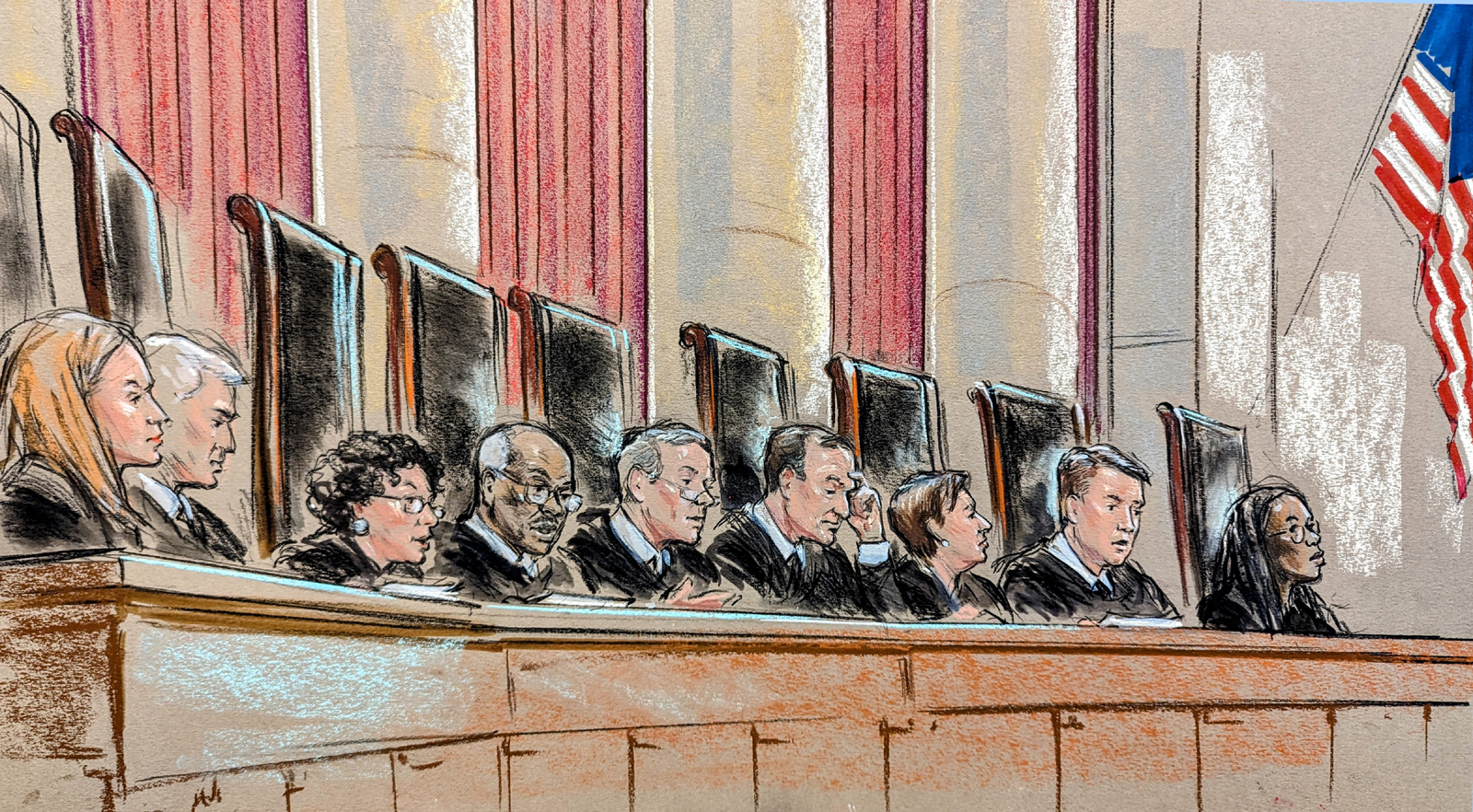Supreme Court’s narrow read of the Lanham Act: More questions than answers
OPINION ANALYSIS
on Jul 5, 2023
at 12:30 pm
“Contemplation of Justice” outside the Supreme Court building. (Thomas Hawk via Flickr)
Last week the Supreme Court held in Abitron Austria GmbH v. Hetronic International, Inc. that the Lanham Act, the federal trademark statute, reaches only conduct “where the claimed infringing use in commerce is domestic” and that confusion to consumers in the United States is not relevant to the analysis. In setting aside a jury verdict of about $90 million for infringing acts that largely occurred in Europe, the court unanimously concluded that under step one of its test to determine whether a statute applies extraterritorially, Congress did not provide the requisite clarity in the Lanham Act’s text to overcome the presumption against applying a law abroad.
But the court was deeply divided on how to apply step two of the test: whether the focus of the statute allows it to be applied outside the United States. The five-member majority, in an opinion written by Justice Samuel Alito, held that the conduct related to the statute’s focus, which is “use in commerce,” must occur in the United States. By specifically refusing to say what “use in commerce” means, the majority opinion is almost certainly a recipe for significant future litigation in the lower courts. In a concurring opinion joined by three colleagues, Justice Sonia Sotomayor would have held that a defendant can be liable under the Lanham Act for infringement that took place abroad if there was a likelihood of consumer confusion in the United States.
The background
Hetronic International Inc. makes, sells, and services radio remote controls for construction equipment, which have a distinctive trademark registered in the United States. It licensed Abitron, a German company, to distribute its products in Europe. Hetronic claims that Abitron engaged in secret reverse engineering and, after the companies parted ways, began selling Hetronic-branded products without Hetronic’s permission. Even though Abitron largely made sales in Europe, Hetronic sued on its home turf, the Western District of Oklahoma. Hetronic invoked two provisions of the Lanham Act that prohibit use in commerce of a trademark in a manner that is likely to cause confusion. A jury awarded Hetronic $90 million in damages.
The issue before the Supreme Court was whether and to what extent the Lanham Act applies extraterritorially. The case did not arrive at the court on a blank slate. In 1952, the court held in Steele v. Bulova Watch Co. that the Lanham Act covered the conduct of a United States citizen who sold in Mexico luxury watches falsely stamped with a U.S. trademark. The Steele court zeroed in on the harmful effects the counterfeit watches had in the United States. In the decades after Steele, the court has developed a two-step test to ascertain whether a federal law applies outside the United States. The test is premised on the presumption that a U.S. law does not generally apply abroad. In step one of this analysis, a court asks if there is an affirmative indication that Congress intended for a particular law to reach foreign conduct. If the answer is no, a court then determines in step two the “focus” of the statute to see if the lawsuit triggers a permissible domestic application of the statute.
Alito’s majority opinion
All members of the court agreed that under step one of the test, the Lanham Act has no extraterritorial application. It is not contested that the act does not have an express statement of extraterritoriality. Hetronic, however, argued that an extraterritorial intent could be inferred from Congress’s adoption of a uniquely broad definition of commerce in the act, which applies to “all commerce which may lawfully be regulated by Congress.” But Alito stated that “[i]t is a ‘rare statute that clearly evidences extraterritorial effect despite lacking an express statement of extraterritoriality.’” “Generic” phrases referring to what Congress may regulate as a constitutional matter, Alito wrote, do not rebut the presumption against extraterritoriality..
Turning to step two and writing only for a five-member majority, Alito emphasized that identifying the focus of a statute is not enough. The key is the “conduct relevant to the statute’s focus,” and that conduct must occur in the United States. Alito held that the focus of the Lanham Act is the infringing use of a trademark in commerce; consumer confusion is not a focus of the statute. In the view of the majority, confusion is only “a necessary characteristic of an offending use.” Because the issue “turns on the location of the conduct relevant to the focus,” “use in commerce” of a trademark in the United States “provides the dividing line between foreign and domestic applications of these Lanham Act provisions.” In other words, if a false trademark is not used in commerce domestically, the Lanham Act does not apply even if the use creates confusion in the United States.
In reaching his conclusion, Alito dismissed the precedential value of Steele, explaining that (i) the case was decided before the modern two-part test was developed, and (ii) at least some of the “essential steps” of infringement in that case took place on American soil.
Alito also rested his decision in part on international comity. Citing a brief from the European Commission, he noted that if each country were allowed to enforce its trademark law on the basis of extraterritorial effects, the international trademark system “would collapse.” He thereby ignored the position of the Biden administration, which had suggested in a friend-of-the-court brief that a focus based on consumer confusion in the United States would best adhere to the intent of the Lanham Act and would be most consistent with the Steele precedent. It is unusual for the court to accept the view of a foreign state over that of the executive branch on the foreign policy implications of a legal interpretation.
Jackson’s concurring opinion
Justice Ketanji Brown Jackson provided the decisive fifth vote for Alito’s majority opinion applying the “use in commerce” standard. But she wrote a separate concurring opinion stating that the standard should be applied broadly. In her view, “a ‘use in commerce’ does not cease at the place the mark is first affixed, or where the item to which it is affixed is first sold.” During oral argument, Jackson asked a series of hypothetical questions involving how the Lanham Act would apply if American college students studying in Germany brought home counterfeit bags manufactured and sold in that country. In her concurring opinion, Jackson expanded on that and stated that if the students decided to resell the bags in the United States, then the German manufacturer may be liable under the Lanham Act because the bags have now been placed in domestic commerce – even though, as Jackson acknowledged, the foreign manufacturer “never sold the bags in, or directly into, the United States.” In a footnote, Jackson also suggested that a foreign defendant can be liable if its infringing products are sold into the United States through a website operated by a third party even though it has no control over those sales. In response, Alito stated that this case does not provide the “occasion to address the precise contours of” the phrase “use in commerce.”
Sotomayor’s concurring opinion
In an opinion joined by Chief Justice John Roberts, Justice Elena Kagan, and Justice Amy Coney Barrett (a highly unusual ideological line-up for sure), Sotomayor would have adopted, consistent with the position of the Biden administration, consumer confusion as the focus of the Lanham Act. On this view, infringing conduct that took place overseas would come within the purview of the statute as long as American consumers were confused. Sotomayor contended that the majority has the statute backward: In her view, the law’s prohibition of “the use in commerce” of offending trademarks is designed to protect U.S. consumers from confusion. Preventing confusion is the ultimate statutory goal. As a result, it would be appropriate to apply the Lanham Act to extraterritorial conduct that has the proscribed effects in the United States.
Sotomayor wrote that the majority’s reading of the law, by carving out most foreign infringement activity, frustrates clear congressional intent. She also argued that her interpretation of the Lanham Act would have been more faithful to Steele. In her view, the majority has crafted a third step to the two-step test for extraterritoriality and converted the test “into a myopic conduct-only test.”
Uncertain scope
The bottom-line result of Abitron is that the Lanham Act does not generally cover conduct outside the United States. Going forward, it will be more difficult for American brand owners to protect their intellectual property rights internationally. But significant uncertainty exists regarding the scope of “use in commerce” for purposes of invoking the Lanham Act. Lower courts could apply Alito’s majority opinion to mean that a foreign defendant is liable only if it directly sells products in or into the United States. Or, they can embrace Jackson’s view to hold a foreign defendant liable based on what happened with the infringing product after the defendant has relinquished control over it.






